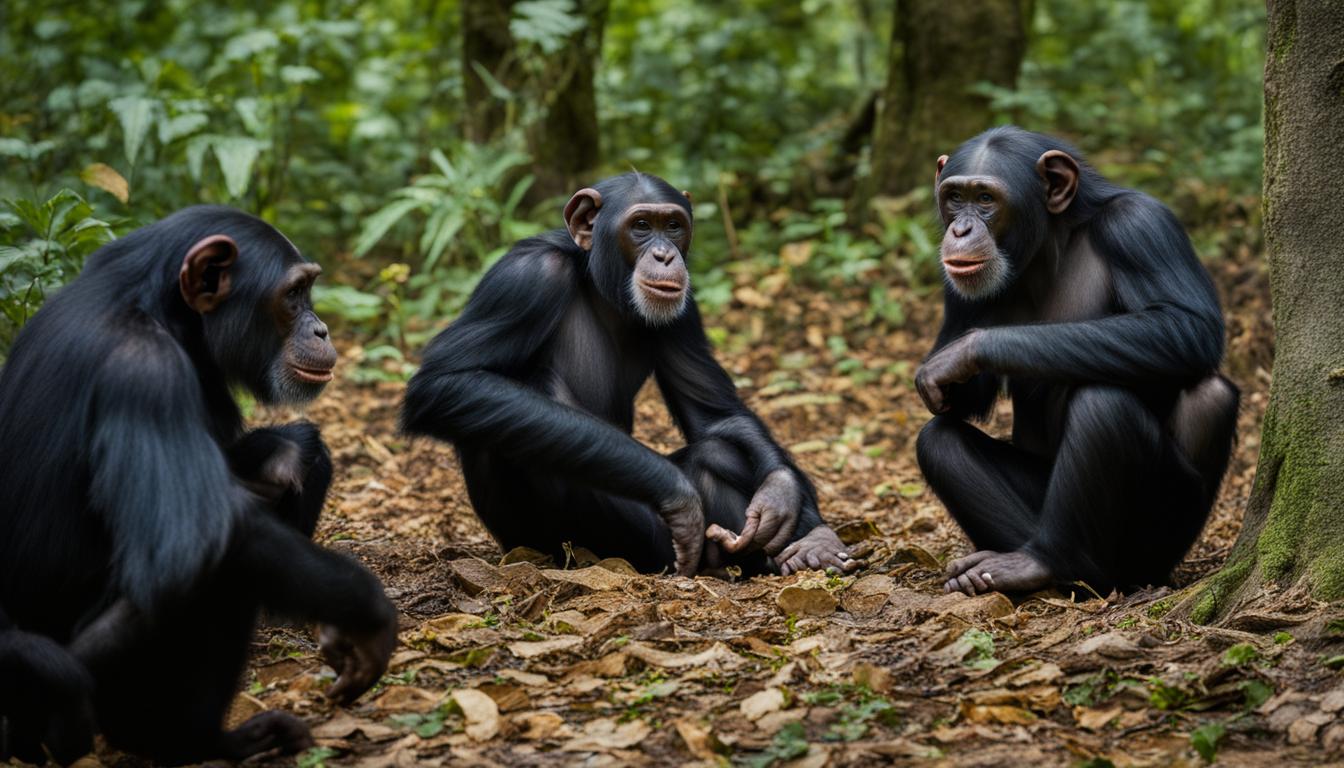Chimpanzees, our closest cousins in the animal kingdom, have fascinating social structures that revolve around complex hierarchies. In this article, we explore the dominant hierarchy in chimpanzees and how they establish their social structure.
The complex dynamics of chimpanzee social hierarchy
The social hierarchy in chimpanzee groups is a fascinating and intricate system that governs their interactions and behaviors. Within a chimpanzee hierarchy, individuals hold different ranks or positions, ranging from high-ranking to mid-ranking and low-ranking. Dominance plays a crucial role in determining the social rank of a chimpanzee, with higher-ranking individuals exhibiting more dominant behaviors and having stronger relationships with other members of the group.
The hierarchy influences various aspects of chimpanzee life, including access to resources, mating opportunities, and social interactions. High-ranking individuals tend to have more allies and may have greater access to food and desirable mates. On the other hand, low-ranking individuals often show submissive behaviors and may have fewer strong relationships within the group. This complex dynamic of social rankings shapes the social structure and interactions within chimpanzee communities.
Chimpanzee dominance relationships are constantly being negotiated and challenged. Aggression, coalition formations, and alliances are some strategies employed by chimpanzees to gain or maintain dominance. These power struggles can lead to conflicts, both within and between groups, as individuals and coalitions vie for higher social rank and the associated benefits. Understanding the complex dynamics of chimpanzee social hierarchy provides valuable insights into their social behavior and helps researchers comprehend the complexities of this remarkable species.
To illustrate the complexity of chimpanzee social hierarchy, consider the following table:
| Rank | Description |
|---|---|
| Alpha Male | The highest-ranking individual in the group, often attains the position through aggression and forming alliances |
| Alpha Female | The highest-ranking female in the group, but usually outranked by the alpha male |
| High-ranking individuals | Exhibit dominant behaviors, have more allies, and enjoy greater access to resources and mating opportunities |
| Mid-ranking individuals | Hold intermediate positions in the hierarchy, with varying levels of dominance |
| Low-ranking individuals | Show submissive behaviors and have fewer strong relationships within the group |
Quote: “The social hierarchy in chimpanzee groups is a fascinating example of how dominance and relationships shape the behavior and interactions of these intelligent primates.” – Chimpanzee researcher
The importance of social rankings in chimpanzee groups
The social rankings in chimpanzee groups are not merely a matter of power and dominance; they play a significant role in the overall social dynamics and well-being of the community. Higher-ranking individuals often have better access to food, mating partners, and other resources, leading to improved reproductive success and survival. The hierarchy also helps maintain order and stability within the group, as individuals understand their place and roles based on their social rank. Establishing and navigating the social hierarchy is a critical aspect of chimpanzee life, and studying these complexities provides valuable insight into the behavior and social organization of these remarkable animals.
Family and Social Life in Chimpanzee Groups
Chimpanzees have a rich and dynamic social organization that revolves around their extended family groups. These groups consist of multiple individuals and form the foundation of their society. Chimpanzees live in a fission-fusion social structure, meaning that they break into smaller subgroups and periodically come together.
Within these family groups, family relationships play a critical role. Chimpanzees form lifelong bonds with their mothers and other group members, which are essential for their survival and well-being. Female chimpanzees give birth approximately once every five years and rely on the support of other females within the group to care for their infants. Males also play a significant role in the lives of the young and actively protect them.
The hierarchy within chimpanzee groups determines the roles and relationships among its members. It influences various aspects of their lives, including access to resources, mating opportunities, and social interactions. Higher-ranking individuals typically have more privileges and preferential access to limited resources within the group. This hierarchical structure also plays a crucial role in maintaining social order and resolving conflicts.
Role of Family Bonds and Hierarchy in Chimpanzee Societies
Family bonds and the hierarchical structure in chimpanzee societies serve important purposes. The family bonds provide emotional support, protection, and assistance in raising offspring. The hierarchical structure helps maintain social order, reduces conflict within the group, and facilitates cooperation. It also influences the transfer of knowledge and cultural behaviors among group members.
| Benefit | Example |
|---|---|
| Emotional Support | Chimpanzees show affection through grooming rituals, which help to strengthen bonds within the group. |
| Cooperative Care | Females within the group assist each other in raising offspring, providing mutual support and increasing the chances of survival. |
| Resource Access | Higher-ranking individuals have preferential access to food and other limited resources, which benefits both them and their allies. |
| Conflict Resolution | The hierarchy helps to minimize conflicts within the group by establishing clear dominance relationships and reducing the need for physical aggression. |
The family bonds and hierarchy in chimpanzee societies are essential components of their social organization. These structures contribute to their survival, cooperation, and the transmission of knowledge from one generation to the next, ensuring their continued adaptation and success in the wild.
The Cultural Aspects of Chimpanzee Society
Chimpanzees are not only known for their complex social hierarchies but also for their intriguing cultural behaviors. Much like humans, these intelligent primates exhibit the transmission of knowledge and traditions from one generation to another. They engage in a wide range of cultural practices, which contribute to the social organization and cohesion of their groups.
“Chimpanzee society is characterized by their communal living, where they engage in activities together like fishing for termites or enjoying ripe fruits.”
One remarkable aspect of chimpanzee culture is their ability to learn from each other. They observe and imitate behaviors, such as using tools for foraging or hunting. This cultural transmission helps them adapt to their environment and acquire essential skills for survival. It also lays the foundation for cooperative behaviors within the group, fostering a sense of shared knowledge and collective problem-solving.
A crucial element of chimpanzee culture is their communication system. These primates rely on a wide range of vocal expressions and calls to convey different messages to their group members. Through vocalizations, they can communicate the presence of food, warn others of potential dangers, or signify their emotional states. Additionally, tactile rituals, such as touching and grooming, play a vital role in social bonding and the expression of deep emotional connections.
The Social Significance of Cultural Behaviors
The cultural aspects of chimpanzee society are not just mere curiosities; they have significant social implications. Communal activities and shared knowledge strengthen the bonds within the group, promoting cooperation and mutual assistance. Chimpanzees who engage in cultural behaviors are likely to experience a sense of belonging and enhanced social cohesion, contributing to the stability of their communities.
Furthermore, the sharing of knowledge and resources among chimpanzees establishes a framework for social learning and innovation. This cultural exchange allows individuals to acquire new strategies and techniques to improve their foraging or mating success. It also facilitates the spread of cultural behaviors throughout the group, leading to the development of unique traditions and customs.
| Chimpanzee Cultural Behaviors | Examples |
|---|---|
| Tool Use | Using sticks to extract termites from mounds |
| Communication | Distinct vocalizations for food or predator alerts |
| Cooperative Hunting | Working together to capture small prey |
| Communal Foraging | Gathering in groups to consume ripe fruits |
Through their cultural practices, chimpanzees demonstrate the richness and complexity of their social lives. These behaviors highlight their ability to adapt, learn, and thrive within their natural habitats. By exploring the cultural aspects of chimpanzee society, we gain a deeper appreciation for their remarkable intelligence and the fascinating similarities they share with us, their closest relatives in the animal kingdom.

Conclusion
The social hierarchy in chimpanzee groups is a fascinating aspect of their societies. Through dominance, relationships, and power struggles, these intelligent creatures establish and maintain their social structure. By understanding the dynamics of chimpanzee social hierarchies, we gain valuable insights into their behavior and communication.
Chimpanzee society is complex, with different ranks and positions within the hierarchy. The level of aggression and the strength of relationships determine an individual’s dominance. This hierarchy influences various aspects of their lives, from access to resources and mating opportunities to social interactions.
Family and social bonds are crucial for chimpanzees. They live in extended family groups and rely on each other for support. Female chimpanzees have lifelong bonds with their mothers and other group members, while males play a role in protecting and caring for the young. The hierarchy within the group shapes the roles and relationships among its members.
Chimpanzees also exhibit cultural behaviors, transmitting knowledge and traditions from one generation to another. They learn from each other, engage in communal activities, and communicate through vocal expressions and tactile rituals. By delving deeper into the motivations and intricacies of chimpanzee societies, we can continue to appreciate and understand these incredible creatures.
What factors contribute to the establishment of social hierarchies in chimpanzee groups?
In the realm of social hierarchies in chimpanzees, several factors come into play. These include aggressive behavior, grooming alliances, and access to resources such as food and mates. Dominance and submission interactions also play a crucial role in establishing and maintaining social hierarchies in chimpanzee groups.
FAQ
How are social hierarchies established in chimpanzee groups?
Social hierarchies in chimpanzee groups are established through a complex interplay of dominance, relationships, and power struggles. The highest-ranking individual in the group is the alpha male, who attains his position through various strategies such as forming alliances or using aggression.
What determines the dominance of a chimpanzee within the hierarchy?
The dominance of a chimpanzee is determined by their level of aggression and the strength of their relationships with other members of the group. High-ranking individuals are more dominant and may have more allies, while low-ranking individuals are more submissive and may have fewer strong relationships.
How does the hierarchy influence chimpanzee behavior?
The hierarchy influences various aspects of chimpanzee behavior, including access to resources, mating opportunities, and social interactions. Higher-ranking females, for example, have greater reproductive success and access to resources, while their offspring tend to achieve higher status as well.
What is the social structure of chimpanzee groups?
Chimpanzees live in extended family groups consisting of multiple individuals. These groups have a fission-fusion social structure, meaning that they break into smaller subgroups and periodically come together. Family relationships are crucial for chimpanzees, and they have lifelong bonds with their mothers and other members of the group.
What cultural behaviors do chimpanzees exhibit?
Chimpanzees exhibit cultural behaviors such as the transmission of knowledge and traditions from one generation to another. They learn from each other how to use tools, communicate, and engage in various behaviors such as hunting and foraging. They also engage in communal activities like fishing for termites or enjoying ripe fruits.










